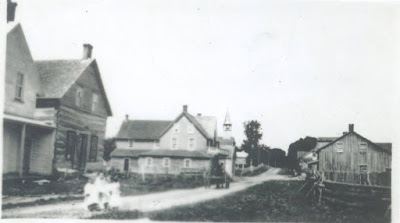The Village of Dunvegan and its Early Settlers
 |
| Taken from the Museum's collection: Dunvegan looking north, 1908 |
The first settlers from Scotland came in 1831 and were the MacRaes. They were followed in 1832 by the
Stewarts, MacPhees, Urquharts, Chisholms, Campbells, other MacRaes, Dewars, and
MacLeods. The first child born in this area was on the 9th
Concession of Kenyon, near the Cotton Beaver one-room schoolhouse. His name was
Donald N. MacLeod.
In the 1880’s, Dunvegan village was the only place
of business in the Northern part of Glengarry. The development of the Railroad
in 1880-1884 brought a lot of business activity to Dunvegan. The chief
businesses included: a grist mill, tannery, asheries, saw mill, tin shop,
blacksmith, shoe makers, and general stores. The first store was located in the
Star Inn, here at the museum. In 1892, a fire broke out and swept through most of the
industrial part of the village. The fire started on the south east corner of Main
Street taking stables, a grist mill, an ashery, and a number of houses on the east side.
The first roads were horse trails through the woods.
These trails were very narrow. They were later replaced by corduroy roads and
then dirt roads and then gravel. The first vehicle to travel the roads was a
lumber wagon. Later came the horse cart, buckboards and then buggies.
There was no resident doctor in Dunvegan’s early
days. Dr. Simpson of Alexandria often came to Dunvegan when a doctor was
needed. When you went for him, the traveller took two horses, one for him. The
first doctor to have an office in Dunvegan was Dr. Willie MacDiarmid. He
arrived in the last quarter of the 18th century and remained in
Dunvegan for a few years. He later moved to Vankleek Hill and was replaced.
Dunvegan saw many different doctors in its early days.
 |
| Taken from the Museum's collection: Photograph of the log church, Dunvegan |
The first church was built in 1840 on land donated
by Norman MacLeod. It was a log building and much of the work was done by
voluntary labour. The present stone church began in 1871 and the formal opening
happened on Sept 9th, 1880. Before there were any church buildings,
services were held under the trees.
The first settled minister of Kenyon Church was Rev.
Adam MacQueen who was a missionary here for three summers before being
ordained. The first cemetery was laid out on the farm of John Campbell but it
was later decided to have it on the present site as it was more central.
The nearest bank was in Montreal.
In the later 1800’s, Glengarry had a population of
26,000 and there were no policemen. To show the honesty of the early settlers, a
story is told of an early settler who was sold a horse by a neighbor but had no
money to pay for it. Notes became more common at this time and a note was made listing a payment due date for the buyer.
A lot has changed in the village of Dunvegan since
its early days. Although its many industries have disappeared and buildings and landmarks have changed, the Museum works to preserve their history so that it can stay alive for generations to come.
No comments:
Post a Comment